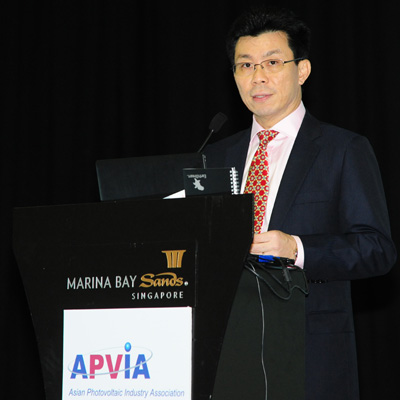
(Picture credit: EMA)
SPEECH BY MR LEE YI SHYAN,
SENIOR MINISTER OF STATE FOR NATIONAL DEVELOPMENT AND TRADE & INDUSTRY
AT THE PV ASIA PACIFIC EXPO
ON TUESDAY, 23 OCTOBER 2012, 0930HRS AT MARINA BAY SANDS EXPO AND CONVENTION CENTRE
Your Excellencies
Ladies and Gentlemen,
Introduction
1. Good morning. Welcome to the second PV Asia Pacific Expo (PVAP). Last year, I participated in the launch of the Asian PV Industry Association (APVIA). I am happy to join 2 you again at this year's expo to progress our discussion on renewable energy.
Global Trends in Renewable Energy and Solar PV
2. With rising energy costs and increasing need for environmental protection, countries around the world have become even more serious in the development and deployment of renewable energy. Global investments in renewables have grown almost six-fold since 2004. 1 From 2011 to 2017, the International Energy Agency (IEA) is predicting that global renewable power generation will increase further by 40%.
3. Amongst renewable sources of energy, the use of solar energy has in fact risen 52% in 2011. 3 Current economic uncertainties notwithstanding, Asia's steady adoption of solar energy would make Asia a large production and deployment site of solar power.
4. In the coming years, China and India are expected to be among the countries with the fastest growth in solar photovoltaics (PV) capacity; while Southeast Asia is emerging as a new growth market for solar PV. Governments in Thailand, Malaysia and Indonesia are keen to accelerate solar deployment. For example, Thailand and Malaysia have set PV installation targets of 2 GW 4 (gigawatt) and 1.3 GW 5 by 2021 respectively. At the company level, REC's integrated solar production facility in Singapore has a module production target of 750 MW for 2012.
Test-bedding projects
5. In Singapore, we too are experimenting with more test-bed PV projects. Recently, Panasonic partnered with the government to launch Asia's first "total energy solutions public housing test -bed" in Punggol Eco-Town. Under this project, Panasonic will install solar panels on an existing public residential building and integrate its home energy management systems. This will help households realise greener lifestyles through greater energy efficiency and demand management.
6. Another example is Keppel Seghers' 1 MW (megawatt) PV system on a waste water treatment plant. This will be Singapore's first commercial-scale PV system to supply solar energy for water treatment.
7. Besides technological innovations, Singapore is also developing new project financing capabilities. We are piloting new financing and business models which will address high upfront costs and further encourage the adoption of solar technologies. Under the first solar leasing project, Punggol Eco-Town will have 2 MW of solar PV capacity.
8. Our test-bedding efforts have catalysed a steady growth in Singapore's total solar installed generation capacity. Over the last three years, grid-connected solar generation capacity in Singapore grew from 1.9 MW to 5.5 MW in 2011.
R&D efforts
9. Singapore offers a sophisticated environment for R&D in clean energy systems. Under the Energy Innovation Programme Office (EIPO), we have set aside $140 million for research into clean energy technologies. Recently, EDB launched a grant call 6 to invite research proposals in the area of solar PV, and EMA a grant call in the area of smart grids. EDB and EMA will announce the selected projects by the end of the year.
10. Going forward, the Solar Energy Research Institute of Singapore (SERIS) will be developing a technology roadmap on Solar Photovoltaics in Singapore. This roadmap aims to chart technology development pathways in order to identify promising technologies best-suited for deployment in Singapore. SERIS is also collaborating with the Energy Research Institute @ NTU (ERI@N) to develop thin-film solar cells which will improve the efficiency of solar PV generation.
11. These initiatives will help us identify new R&D areas and develop innovative solutions to overcome the challenges to solar deployment in the urban settings of Singapore.
Conclusion
13. Thank you.
By :MR LEE YI SHYAN